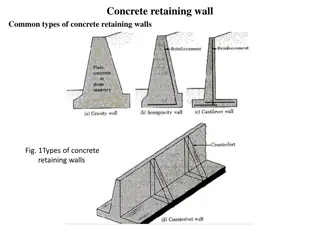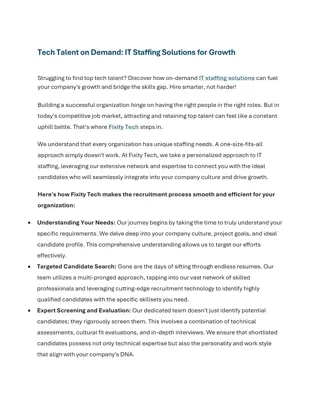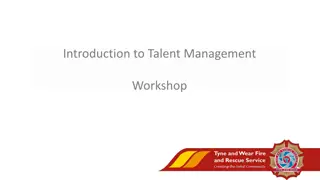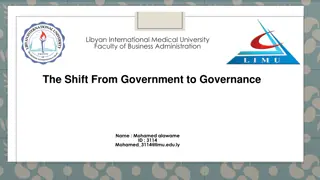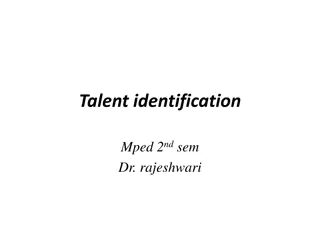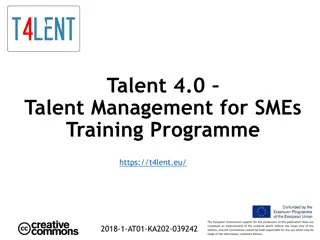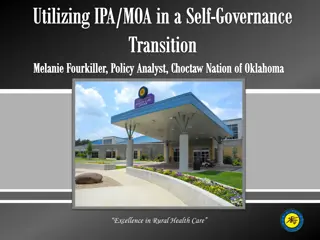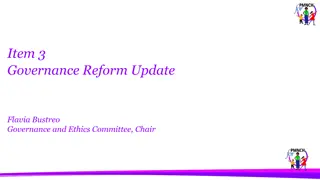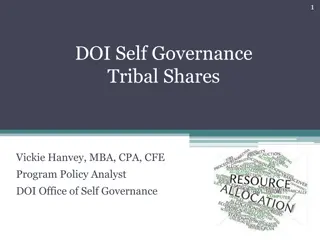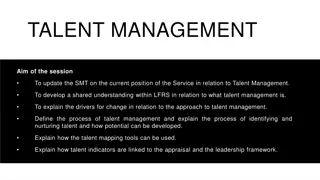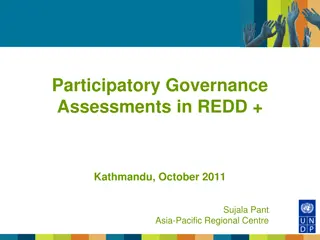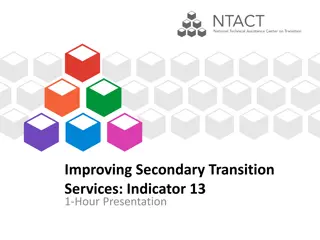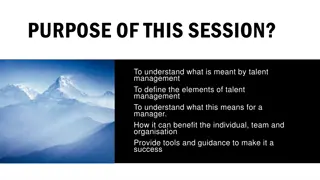Retaining Talent in Self-Governance Transition: Strategies for Success
This article explores strategies for retaining talent during the transition of programs, services, and activities to a tribe under self-governance. It discusses options such as contract, tribal hire, and inter-agency personnel agreements (IPA) or memorandum of agreements (MOA) for retaining federal personnel. The considerations for employment mix and evaluation of human resources policies to accommodate health professionals are also emphasized.
Uploaded on Oct 03, 2024 | 0 Views
Download Presentation

Please find below an Image/Link to download the presentation.
The content on the website is provided AS IS for your information and personal use only. It may not be sold, licensed, or shared on other websites without obtaining consent from the author. Download presentation by click this link. If you encounter any issues during the download, it is possible that the publisher has removed the file from their server.
E N D
Presentation Transcript
Retaining Talent in a Self-Governance Transition Melanie Fourkiller, Policy Analyst, Choctaw Nation of Oklahoma Excellence in Rural Health Care
Background Many transitions of Programs, Services, Functions and Activities to a Tribe under Self- Governance include existing IHS facilities, such as hospitals and/or clinics. Tribes have options to retain the Federal personnel that are providing the PSFA(s) being assumed: o Contract o Tribal Hire o Inter-Agency Personnel Agreement (IPA) o Memorandum of Agreement (MOA)
Background IPAs and MOAs are Federal employees that are assigned to the Tribe Existing Federal staff can convert to either an IPA or MOA upon agreement between the employee, IHS and the Tribe o IPAs are civil service employees o MOAs are commissioned personnel
Employment Considerations The Tribe/TO determines what mix of contract, Tribal hire, and IPA/MOAs to have in the organization Items to consider: o It is least disruptive to existing Federal personnel to offer everyone an IPA/MOA; o IPA/MOAs are a good tool to retain the existing staff performing the PSFAs; o IPA/MOA staff typically cost more than Tribal direct hires; o
Employment Considerations Some Federal staff may prefer a Tribal hire, depending upon their career plans; Tribes will only receive the Direct Contract Support costs for Fringe differential associated with Tribal hires (not IPA/MOA personnel); The Tribe can make policy exceptions in the transition, and then IPA/MOAs would gradually reduce by attrition, thus reducing costs over time.
Employment Considerations The Tribe s evaluation of its Human Resources policies, job descriptions and compensation structure to accommodate Health professionals: o Position Descriptions o Work schedules o Licensure o Continuing education o Recruitment costs (relocation, etc) o Health Professional Salary Schedule competitive with both the market and with existing Federal employment
About IPA/MOAs An Agreement is entered between the IHS, Tribe and the Federal employee; 2-year agreements, with the ability to extend indefinitely; IPA/MOAs retain their Federal employment status, compensation and benefits and perform the same functions;
About IPA/MOAs All Federal employees performing PSFAs to be assumed by a Tribe may be eligible, except: o Employees not having at least a satisfactory performance rating, or o Employees on a time-limited, temporary or term appointment. Directed and supervised by the Tribe/TO; Federal personnel may be members of a Union, however it is a Tribal choice to recognize unions; Paycheck still comes from the Federal government;
IPA/MOAs and the Funding Agreement Treated as a buy back in the Funding Agreement; The Tribe/TO provides a prepayment to IHS to pay the costs of IPA/MOA staff, which is a rolling balance; Tribe is invoiced monthly to reimburse for IPA/MOAs, along with a Full Cost Recovery Fee. o FCR Fee pays for IHS finance and human resources workload to maintain the Federal employee (functions are typically at the Area Office) o Example: FCR Fee in Oklahoma Area is 2.19%, applied to IPA/MOA cost
Strategies for Retention of Federal Staff Determine as early as possible how employment offers will be made and announce: o All eligible staff to be offered IPA/MOA, or on what other basis? o Will all employees also receive a Tribal hire offer? o Schedule for the transition. Identify the IHS Human Resources Contact, and the Tribal Human Resources Contact
Strategies for Retention of Federal Staff Complete a comparison of Federal vs. Tribal benefits and policy: o Fringe Benefits o Leave Policies (accrual, retention, payment upon separation) o Background Checks o Drug Testing o Holiday Schedule o Others
Strategies for Retention of Federal Staff Get data from IHS: o Number of staff o Title o Grade, step, etc o Compensation level o Special Pays o Employment status o Eligibility for IPA/MOA if not eligible, describe reason
Strategies for Retention of Federal Staff Make determinations on Tribal direct hire offers for transitioning Federal staff o Compensation will the Tribe offer at least the same level of base pay; o Health Professional Salary Schedule, including special pays o Transition of tenure for purposes of leave accrual, leave usage and participation in insurance and retirement plans o Acceptance of any background and drug testing results in the Federal personnel file
Strategies for Retention of Federal Staff Make determinations on Tribal direct hire offers for transitioning Federal staff o Licensure of Health Professionals: in State of practice, or from any State; o Tribal Preferences Indian or Veterans preference, for example; o Transition decisions can be one-time exceptions to Tribal policy, as a means to retain all of the Federal personnel possible; o Option to use the Federal Health Benefit Package for employee health insurance.
Strategies for Retention of Federal Staff Develop and administer Offers of Employment as soon as possible; Tribes/TO have the flexibility to do written Offers of Employment or Letters of Intent to assist in retaining personnel; Offer is made by the Tribe, and can be accepted or declined by the employee; Includes such agreement as type of employment (IPA, MOA or Tribal), base salary, contingency upon background and/or drug testing as applicable, release of information, any licensure requirements.
Strategies for Retention of Federal Staff Offers can be made many months in advance of actually entering an IPA or MOA; Can be very useful to commit both the Tribe and the Federal employee and reduce attrition. The earliest that Offers/Letters of Intent are signed, the more comfortable staff will be, and the less uncertainty and unrest that will result among the staff.
Vacancies During Transition Discuss with IHS in advance the plan for continuing to fill vacancies until the Compact effective date. Options are: o (1) IHS continues to recruit/fill, with or without Tribal input; o (2) IHS effort is deferred in favor of Tribal recruitment for these vacancies; or o (3) there is an agreed upon joint recruitment effort for the transition. It is critical that recruitment efforts do not stall or halt during the transition process.
Vacancies During Transition Tribes/TO can work more flexibly with potential employees to make offers or deliver letters of intent to secure recruitment well in advance of the entire personnel process. Employees hired prior to the assumption date are potentially eligible for IPA/MOA, while employees hired after the effective date will be Tribal hires.
Communication is Key Communication and relationship-building with the Workforce is critical; Employees must feel valued and that the Tribe wishes to retain their service; Communicate early and often in several different forums (materials, letters, web, meetings); Build personal relationships with staff by being present and available;
Communication is Key Host group employee meetings jointly with IHS; Schedule Individual meetings to answer questions, discuss options and make offers; Tribal administration (usually Health and HR officials) must be accessible daily o email/phone o walking around the facility
Maximize Your Retention of Talent Make a determination that all eligible employees can have an offer of IPA/MOA and Tribal Direct Hire; Make HR decisions that facilitate keeping employees on board (example, retention pays and base pay); Communicate! By group, individually and with materials and media. Be present often in the facilities, formally and informally. Answer employee questions as timely and completely as possible.
Resources SGCE: www.tribalselfgov.org Federal Employee Health Benefit Plan information: Personnel Aspects of the ISDEAA Handbook: ISDEAA Handbook



